Agentic AI vs AI Agents: 6 Steps To Build Strong Agentic Ai
Artificial Intelligence (AI) is evolving faster than ever, transforming how businesses automate processes, analyze data, and make decisions. Amid this rapid progress, a new concept—Agentic AI—has emerged, gaining attention among developers, innovators, and enterprise leaders.
But what exactly is Agentic AI, and how does it differ from traditional AI Agents? Understanding “agentic ai vs ai agents” is crucial for organizations and developers aiming to build systems that think, act, and adapt with autonomy.
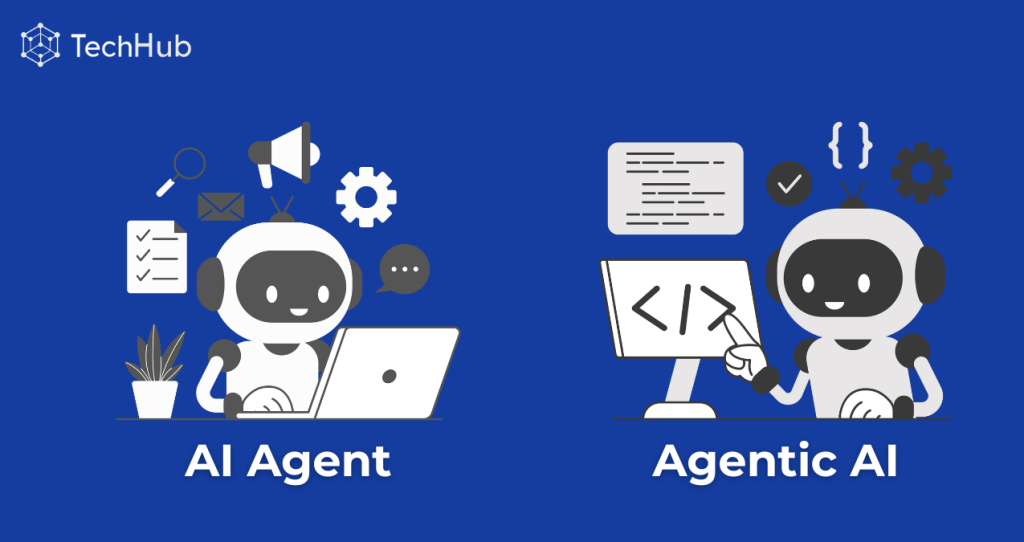
1. Agentic AI vs AI Agents: Definition
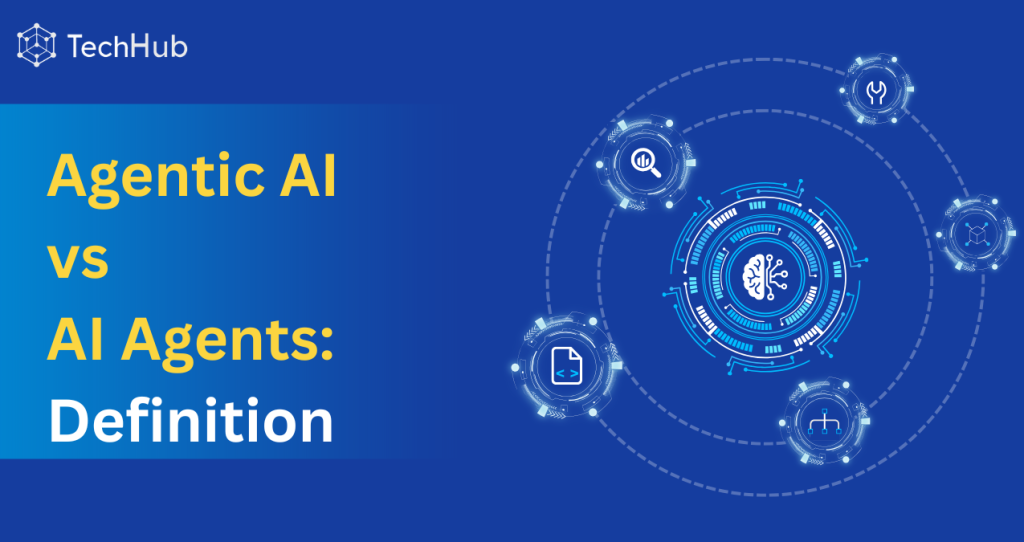
1.1. What Is Agentic AI?
1.1.1. Definition and Core Characteristics
What Is Agentic AI?
When exploring what is agentic ai, it’s important to understand that this concept represents a major evolution in artificial intelligence — one that moves from simple task execution to autonomous reasoning and goal-oriented action.
In essence, Agentic AI is a form of intelligence that can analyze situations, make decisions, and take actions independently based on defined objectives. Unlike traditional AI systems or rule-based AI Agents, Agentic AI is proactive, continuously learning, and capable of adapting to real-world changes in real time.
According to Pega (2024), Agentic AI enables systems to “sense, reason, decide, and act” autonomously across workflows — turning automation into intelligent orchestration that drives smarter business outcomes. This highlights how Agentic AI serves as a bridge between automation and adaptive intelligence.
So, what is agentic ai in practical terms? It’s a self-managing digital intelligence that not only reacts to inputs but also plans, reasons, and executes tasks aligned with its overarching goals. It acts much like a human collaborator — capable of understanding context, learning from feedback, and optimizing its performance over time.
The core characteristics of Agentic AI include:
- Autonomy: The ability to make decisions and perform actions independently without direct human oversight.
- Learning Ability: Continuous improvement through iterative learning and self-refinement.
- Context Awareness: Understanding the environment and user intent before taking action.
- Goal-Driven Intelligence: Every decision and behavior aligns with a purpose or target outcome.
Ultimately, when organizations ask “what is agentic ai,” the answer lies in its ability to operate with self-direction, adaptability, and intelligence that mirrors human problem-solving — redefining how AI systems perform, scale, and evolve.
1.1.2. Real-World Examples of Agentic AI
Real-world applications of Agentic AI are increasingly visible in:
- Autonomous trading systems that analyze and execute financial decisions.
- Virtual AI copilots assisting users across multiple tools and workflows.
- Self-operating robots in logistics, manufacturing, and smart cities.
These examples show why Agentic AI is considered the next leap toward adaptive, goal-oriented automation.
1.2. What Is an AI Agent?
1.2.1. Definition and Functionality
When exploring what is an AI agent, it can be defined as a programmed software entity designed to perform specific and limited tasks within a clearly predefined scope. These systems follow a set of rules or algorithms to execute functions efficiently, often automating repetitive or data-driven processes.
In a business context, what is an AI agent typically refers to technologies such as chatbots, recommendation engines, virtual assistants, and workflow automation bots. They are reactive by nature — operating only when given explicit commands or inputs — and are confined to the boundaries set by human developers.
Unlike Agentic AI, which exhibits autonomy and self-directed decision-making, traditional AI Agents depend on preprogrammed logic and cannot adapt beyond their intended purpose. This limitation highlights why Agentic AI is viewed as the next evolution in intelligent systems — capable of understanding goals, planning actions, and adapting dynamically to achieve outcomes.
1.2.2. Types of AI Agents
There are several categories of AI Agents, including:There are several main categories of AI Agents, each defined by how they process information and make decisions:
- Reactive Agents: Respond directly to environmental inputs (e.g., customer service chatbots).
- Model-Based Agents: Use internal models to simulate environments and predict future outcomes.
- Goal-Based Agents: Choose actions that help achieve specific objectives or results.
- Utility-Based Agents: Evaluate multiple outcomes using reward or utility functions to select the most beneficial action.
These examples demonstrate the foundational nature of AI Agents — powerful tools for automation, yet still dependent on human oversight. As organizations seek more flexible, adaptive, and intelligent systems, the transition from AI Agents to Agentic AI becomes a critical step toward achieving full autonomy in enterprise operations.
2. Agentic AI vs AI Agents — Key Differences
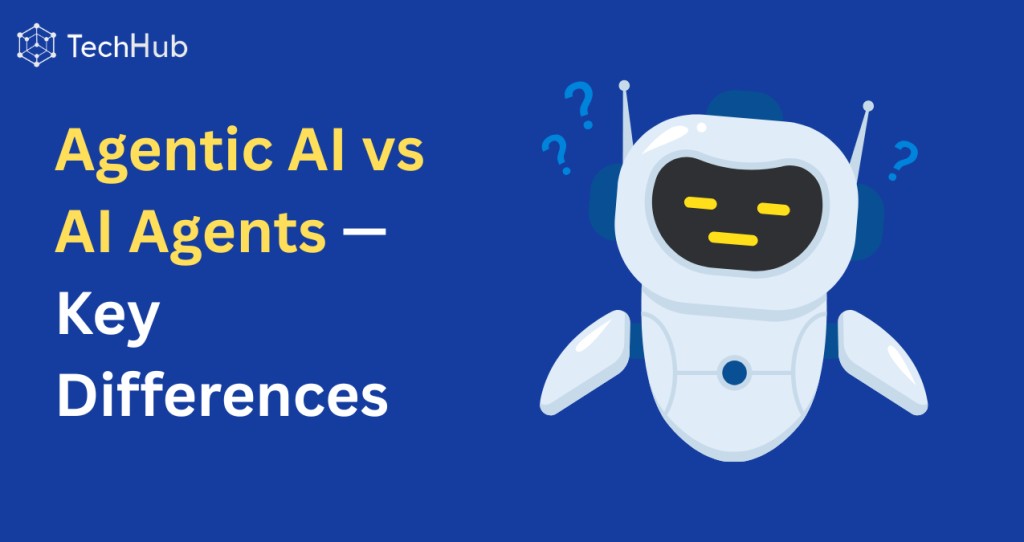
2.1. Autonomy and Decision-Making
When analyzing agentic ai vs ai agents, the most fundamental distinction lies in autonomy. Agentic AI operates independently, capable of complex reasoning, prioritization, and self-directed decision-making based on predefined goals. It can assess situations, plan actions, and execute solutions without continuous human intervention.
By contrast, AI Agents function under strict logical constraints. They follow predefined workflows and respond only to specific triggers or conditions. This limits their ability to adapt or act beyond programmed boundaries, making them dependent on human-defined rules for every decision.
2.2. Scope and Complexity
Another key aspect in the agentic ai vs ai agents comparison is the scope of capability. Agentic AI can manage multiple objectives simultaneously, integrate across interconnected systems, and adapt its strategies based on evolving contexts or user inputs. This enables it to function effectively in dynamic environments, such as large-scale enterprise operations or autonomous systems.
Meanwhile, traditional AI Agents are designed for narrow, rule-based functions—handling repetitive or predictable tasks such as scheduling, customer support, or data categorization. They excel in execution speed but lack the flexibility to handle complex or uncertain scenarios.
2.3. Adaptability and Context Awareness
A defining feature of Agentic AI is its ability to perceive and adapt to contextual changes. It can analyze real-time data, recognize new patterns, and modify its actions accordingly to maintain efficiency and accuracy. This level of adaptability allows Agentic AI to continuously evolve, improving performance without manual updates.
In contrast, AI Agents remain reactive. They rely on fixed instructions and lack the contextual awareness needed to interpret subtle shifts in data or user behavior. As a result, they perform well in stable environments but struggle when faced with dynamic or unpredictable conditions.
2.4. Real-World Applications Comparison
The practical differences between agentic ai vs ai agents become clear when looking at real-world applications. Agentic AI powers advanced technologies such as autonomous vehicles, AI copilots, and intelligent decision-making bots—systems that must reason, learn, and act in complex, uncertain situations.
Conversely, AI Agents are commonly used in customer service automation, recommendation engines, and workflow management tools. While these applications deliver efficiency, they operate within narrow parameters and depend on human input for direction or refinement.
Summary
In summary, the comparison of “agentic ai vs ai agents” reveals a clear shift from reactive automation toward intelligent autonomy. Agentic AI represents a transformative leap—where systems evolve from task executors to proactive collaborators capable of understanding goals, making decisions, and driving innovation across industries.
3. How to Build Agentic AI Systems
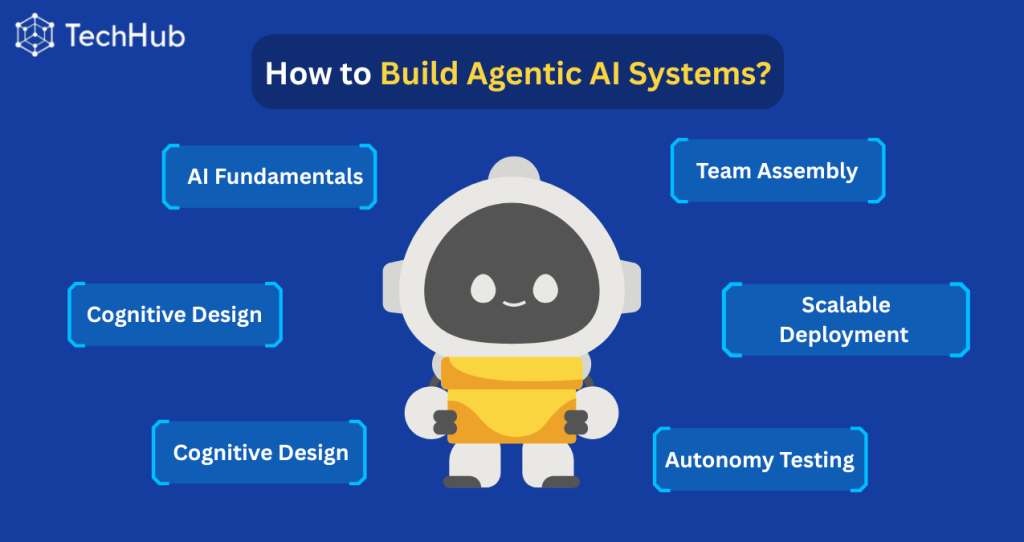
Step 1: Understand the Basics of AI Development
Before exploring how to build Agentic AI, it’s essential to understand the fundamentals of AI system design and training.
Every AI model follows a core framework: data → model → algorithm → feedback loop.
- Data forms the foundation for training and performance accuracy.
- Model defines how information is interpreted.
- Algorithm enables reasoning and learning.
- Feedback loop ensures continuous refinement.
Mastering these basics helps businesses define measurable goals, which are the foundation for autonomous learning — the core of every Agentic AI system.
Learn more: How To Make an AI: A Beginner’s Guide To Building Your Own
Step 2: Define Goals and Tasks for Your Agentic AI
A critical part of how to build Agentic AI is defining clear objectives and measurable outcomes.
Unlike traditional AI, Agentic AI thrives on goal-oriented intelligence — it doesn’t just react but acts with intent.
To begin, organizations should:
- Identify desired outputs and success indicators.
- Define key performance metrics for adaptability.
- Establish feedback mechanisms for continuous learning.
Practical examples include:
- Automating workflows for process efficiency.
- Predictive analytics to improve business forecasting.
- Intelligent decision support systems that augment human insight.
By structuring your project around real-world use cases, you lay the foundation for scalable and intelligent automation.
Step 3: Design the Cognitive and Decision-Making Architecture
At this stage of how to build Agentic AI, autonomy begins to take shape.
A cognitive architecture must be designed to support reasoning, planning, and self-directed actions.
This includes:
- Goal-based reasoning for independent decision-making.
- Multi-agent coordination through APIs or workflow integration.
- Continuous learning loops for adaptability and precision.
For deeper technical guidance, visit: How To Hire An AI Builder Or AI Software Developer To Build Smart Solutions
Understanding this architecture is vital for anyone learning how to build Agentic AI systems that can think, adapt, and act without constant human input.
Step 4: Assemble the Right AI Development Team
The next step in how to build Agentic AI is assembling a multidisciplinary development team.
You’ll need a mix of technical and strategic talent, including:
- AI Engineers & Data Scientists – Model building and optimization.
- Backend/API Developers – System integration and scalability.
- Product Managers & AI Ethicists – Governance and compliance oversight.
If your organization lacks in-house expertise, flexible staffing solutions can bridge the gap:
- Hire Developers for rapid onboarding of AI specialists.
- IT Staffing Solutions / Remote IT Staffing to expand capacity efficiently.
Leveraging expert staffing ensures Agentic AI development remains on schedule, scalable, and compliant while internal teams focus on innovation.
Step 5: Deploy, Scale, and Operate (BOT Model Option)
Deployment is where theory becomes reality — a crucial stage in how to build Agentic AI for enterprise environments.
An effective model for scaling is the Build-Operate-Transfer (BOT) approach:
- Build: Develop and train AI systems with expert support.
- Operate: Collaboratively manage and optimize system performance.
- Transfer: Gradually shift operations to internal teams.
This method ensures a smooth transition and long-term operational independence.
Step 6: Test Autonomy and Continuous Learning
A vital part of how to build Agentic AI responsibly is continuous validation and refinement.
Post-deployment, you must evaluate performance, safety, and adaptability through:
- Autonomy testing: Observe decision patterns for consistency.
- Goal-shift simulations: Test how the system adapts to changing objectives.
- Model retraining: Keep learning models updated with fresh data.
These steps maintain performance accuracy while preventing model drift.
Challenges in Building Agentic AI
Even with a clear roadmap for how to build Agentic AI, several challenges persist:
- Ethical & Safety Risks: Define behavioral boundaries.
- Human Oversight: Maintain human-in-the-loop for critical tasks.
- Integration Complexity: Ensure seamless interaction between multiple AI agents.
By addressing these challenges proactively, organizations can build trustworthy, high-performing Agentic AI systems ready for real-world application.
4. Benefits and Future of Agentic AI
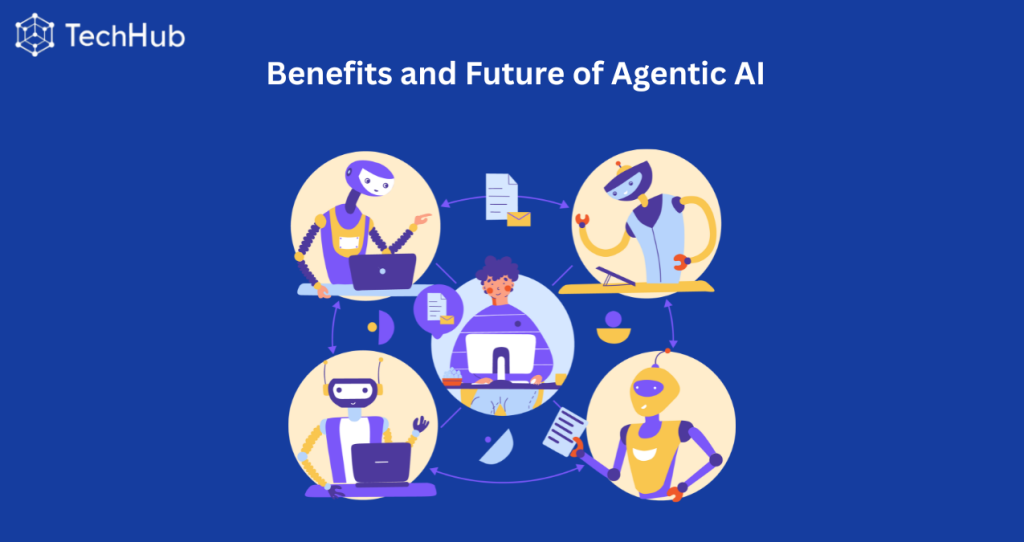
4.1. Advantages of Agentic AI over Traditional AI Agents
Agentic AI delivers significant advantages compared to traditional AI Agents. One of the key benefits lies in its greater efficiency and adaptability — it can analyze changing environments, make autonomous decisions, and adjust strategies in real time. This dynamic nature allows Agentic AI to handle complex workflows that fixed-rule AI Agents cannot manage.
Another major advantage is enhanced cross-agent collaboration. Agentic AI systems can coordinate with other intelligent agents or digital platforms, sharing insights and aligning actions toward common objectives. This leads to more synchronized and outcome-driven operations across departments or systems.
Lastly, Agentic AI reduces human workload through intelligent automation. By taking over decision-heavy or repetitive tasks, it enables human teams to focus on creative, strategic, and value-driven activities — ultimately increasing productivity and innovation.
4.2. The Future Outlook
The future of agentic ai marks a defining shift in how organizations design and deploy intelligent systems. As this technology evolves, it is expected to power IoT devices, personal AI assistants, and adaptive digital ecosystems that operate seamlessly without human intervention.
According to current industry insights, Agentic AI is set to become the foundation of next-generation enterprise intelligence — transforming business operations from reactive automation to proactive, self-optimizing systems. Companies that adopt Agentic AI early will gain a strong competitive edge in automation, innovation, and operational intelligence, leading their markets into the era of autonomous digital transformation.
Conclusion
Agentic AI represents the future of intelligent systems—AI that doesn’t just respond but acts with intent.
While AI Agents remain vital for routine automation, Agentic AI introduces the power of goal-driven autonomy and contextual intelligence.
Understanding “agentic ai vs ai agents” empowers enterprises to invest strategically in the next era of AI innovation—where intelligent systems think, adapt, and collaborate like humans.


